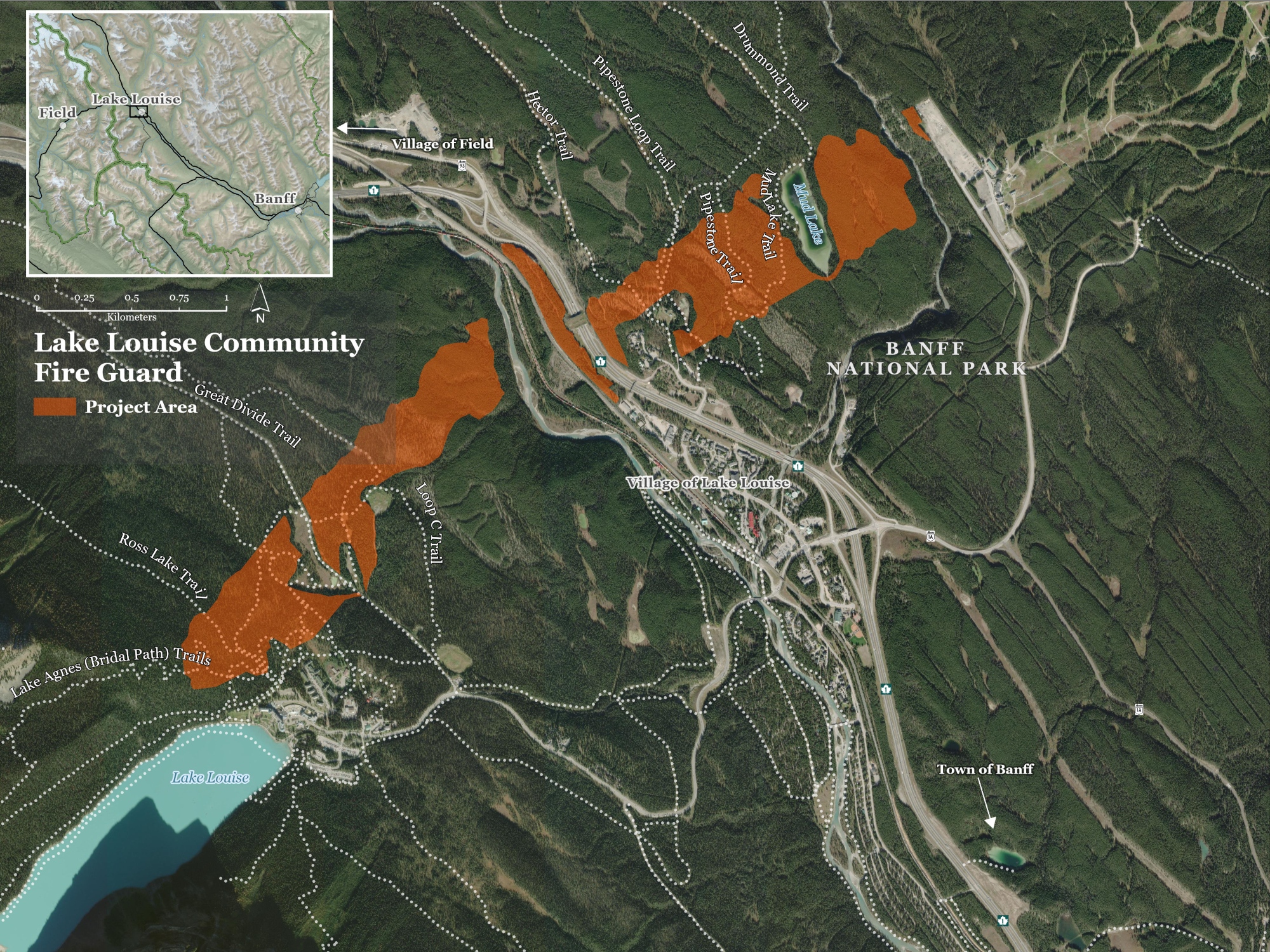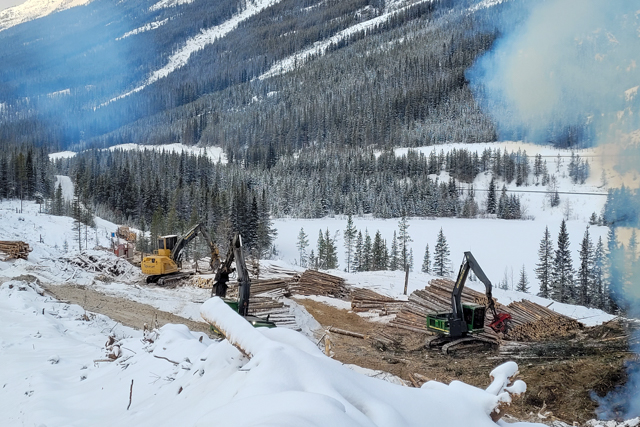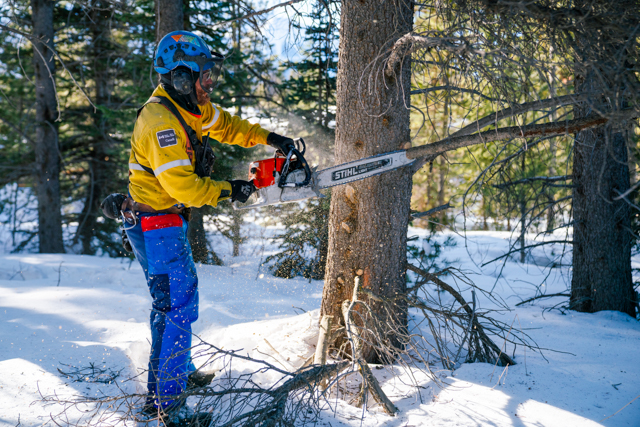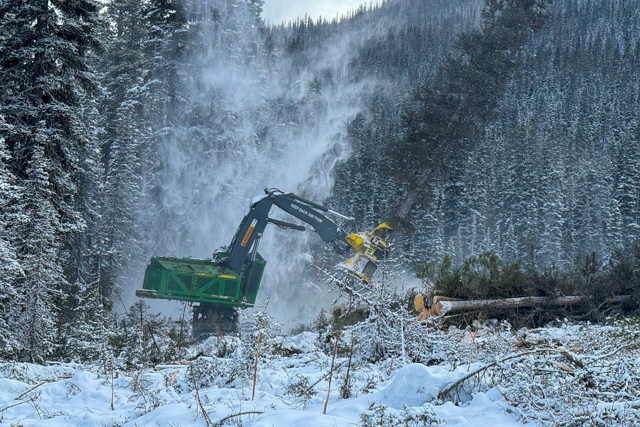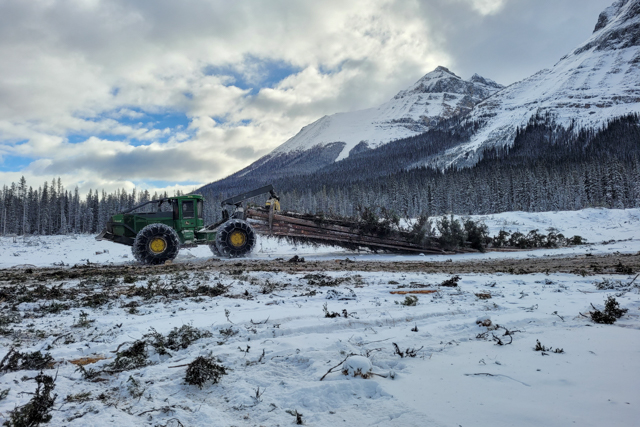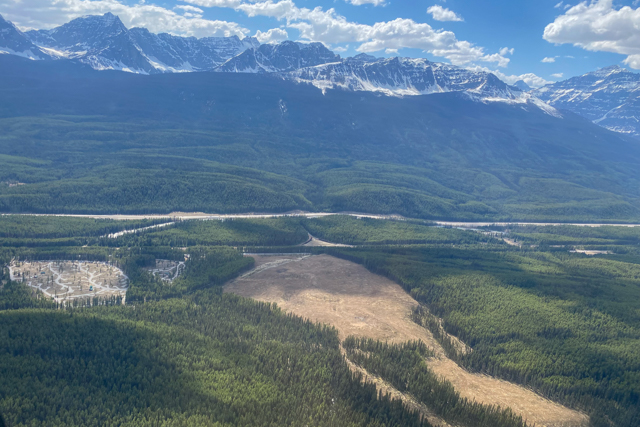
Fire protection and restoration projects
Banff National Park
In the mountain national parks, Parks Canada is working to create healthier landscapes that are more resilient to climate change and the impacts of wildfires. One of the ways Parks Canada does this in Banff National Park is through our fire management program.
As our climate changes, fire seasons are becoming longer, fires are getting larger, and burning more severely. Drought is expected to increase resulting in dry, flammable conditions. By reintroducing fire to landscape in Banff National Park through prescribed fire and wildfire management and, through strategic fuel management, we can create more diverse landscapes, and improve ecosystem resilience. A resilient Banff National Park means that the forests and ecosystems within can recover and persist even with the predicted impacts of climate change.
Creating resilient landscapes
Diversity is key! From meadows to Douglas-fir stands, diverse habitat patches provide room for critters big and small. Diverse forests are able to better withstand the negative impacts of climate change, such as drought, loss of habitat, and severe wildfires. Fire is a natural park of the mountain park ecosystem, so by reintroducing fire to Banff National Park through prescribed fire and wildfire management, we can create healthier, more resilient landscapes.
Guided by the 2020 Fire Management Plan for Banff, Yoho, and Kootenay National Parks, Parks Canada continues to implement the plan as conditions allow. Below you will find information on fire protection and restoration projects within Banff National Park.
Quick facts
- Fire reduces the buildup of dense trees, like lodgepole pine and spruce and dead and down wood, opening up the forest and creating better growing conditions for buffalo berries, a critical food source for grizzly bears.
- Prescribed fire helps to maintain and restore native meadows and grasslands, creating better growing conditions for drought and fire tolerant species like Douglas fir and aspen.
- A mosaic of habitat types can limit the size of fires. While wildfires are difficult to suppress in dense pine stands, patches of open meadows and grasslands decrease the fire’s intensity and represent areas where fires can be extinguished by fire personnel or rain more easily. Previously burned areas will also have less fuels available on the forest floor, further reducing the spread and growth of wildfire. It also means more useable space for wildlife, from pine martens to grizzly bears and everything in between.
Prescribed fires
Reintroducing fire? Prior to European settlement, fires in areas where Banff National Park now exists, were lit by both natural causes, like lightning, and also by Indigenous Peoples to maintain travel routes and support important plant and wildlife species. With the creation of the national park in 1885, Indigenous cultural fire practices were banned, and fire was suppressed for almost a century, until 1983.
This has resulted in a build-up of dense, flammable vegetation across much of the park. The dense forests blanketing our valley bottoms increase the potential for larger and more intense wildfires. To address this, Parks Canada began reintroducing fire to the landscape in 1983 through the use of prescribed fire and moving away from a full wildfire suppression model.
Today, we know that prescribed fires help to restore healthy forests and grasslands and enhance habitat for wildlife. They also reduce the risk of wildfire to our communities.
In Banff National Park, most of the planned prescribed fires will take place in remote backcountry areas. However, two front country burns including; Compound Meadows and Fairholme will occur should conditions permit.
Below is an overview of current prescribed fire projects for Banff National Park:
Fairholme II
Previously burned in 2003, the Fairholme II prescribed fire will improve habitat for wildlife like grizzly bears and will reduce the risk of wildfire to local communities, including the Hamlet of Harvie Heights and the Town of Canmore. A re-burn of the site is required to reduce lodgepole pine regrowth, restore montane grasslands, and open forests that historically occupied this area.
To help ensure smoke impacts are minimized and to protect local communities during fire operations, a smaller scale prescribed fire may be conducted in the spring of 2023 with the main prescribed fire unit to occur later in the fall. Both operations are dependent on favourable weather conditions.
Size: 4,469 hectares
Location: in the front ranges of Banff National Park, between the Banff East Gate and Johnson Lake area, and the Trans-Canada Highway.
Compound Meadows
Prescribed fire will reduce conifer encroachment, stimulate the growth of deciduous and grass species, and restore wildlife habitat in the important valley bottom. It will also help to decrease the wildfire hazard to the Town of Banff.
Size: 194 hectares
Location: On either side of the TransCanada Highway, adjacent to the Town of Banff and Cascade Mountain.
Upper Red Deer Meadows
Date: Spring/Fall
Size: 200 hectares
Location: Upper Red Deer Meadows - Red deer valley between Scotch Camp and Sandhills Cabins.
Additional details: Prescribed fire will restore native meadow habitat in Banff National Park. These meadows provide critical year-round habitat for grizzly bears, wolves, elk, deer, and bison.
Wigmore Meadows
Date: Spring/Fall
Size: 880 hectares
Location: In the Wigmore Valley, south of Windy Warden Cabin.
Additional details: Prescribed fire will restore native meadow habitat in Banff National Park. These meadows provide critical, year-round habitat for mountain sheep, goats, grizzly bears, wolves, elk and bison.
Wildfire risk reduction projects
Did you know: Parks Canada is an active member of the FireSmart™ program?
The FireSmart™ program empowers the public and increases community resilience to wildfire across Canada. FireSmart™ Canada works closely with communities within the national park including the Town of Banff and the Village of Lake Louise. They also work with neighboring communities outside Banff National Park.

Parks Canada is committed to protecting communities in Banff National Park as fire seasons get longer and conditions become drier. In addition to prescribed fire and managed wildfires, Parks Canada actively works with the local communities, like the Town of Banff, to reduce fuels in and around the town site.
Additionally, fire breaks help to protect the town in the event of a wildfire. By removing large patches of forest and creating open meadows, where fire suppression can be more effective, approaching wildfires are slowed, giving firefighters more time anda better ability to protect the community.
This wildfire risk reduction work helps limit fire intensity, reduces the potential for spot fires from windblown embers, and improves the effectiveness of fire suppression techniques.
As part of the Agency’s commitment to reducing the risk of wildfires in the mountain national parks, Parks Canada is proceeding with planned fire management actions in the coming months in Banff National Park. This work is part of the approved Fire Management Plan for the Mountain National Parks (2020). As early as this fall, Parks Canada plans to start work on the following wildfire risk reduction projects in Banff National Park:
Lake Louise Community Fire Guard (expected completion March 31, 2027)
Beginning November 2024, Parks Canada will complete 70.1 hectares (ha) of the 165.4-hectare Lake Louise Community Fire Guard near the community of Lake Louise. This fire guard will be completed using low-impact machinery.
This project is a continuation of over a decade of wildfire mitigation work around the community of Lake Louise and is a pro-active measure to reduce the risk of future wildfires to the community of Lake Louise and surrounding areas.
The project will take two or three winters to complete. Work is scheduled to start as early as November 15 and will finish by March 31, annually. Once complete, the Lake Louise Community Fire Guard will stretch from the south slope of Mount St. Piran behind the Fairmont Chateau Lake Louise to the parking lot and ski runs of Lake Louise Ski Hill on Whitehorn Mountain.
Work will occur on the west side of the Trans-Canada Highway (near the Great Divide Trail) winter of 2024/25.
Closures:
For safety, area closures will be in place during operations. During closures, public access to the project area is strictly prohibited. Regular seasonal access to Lake Louise and facilities will remain open through the project. However, some trails may be impacted.
- Winter 2024/25, trail closures will include Laggan’s Loop, Upper Telemark, Lower Telemark, Peyto ski trails, Loop C Trail, Great Divide Trail, and sections of the Ross Lake Trail. Cross-country ski trails affected by the trail closure will not be track set.
- Closure details for the project area on the east side of the Trans-Canada Highway will be available before work starts in November 2025.
For a list of up-to-date area closures, visit the Important Bulletins page.
For up-to-date information on winter recreational trails, visit the Trail Conditions page.
Smoke:
Woody debris will be piled and burned on-site. Smoke will be visible in the area. Every effort will be made to limit smoke during pile burning. However, unpredicted changes in weather can increase and/or redirect smoke.
Traffic:
During operations, the public can expect to see and hear low-impact machinery and semi-trucks hauling timber.
- Tree felling operations are limited to one hour before dawn and one hour after dusk, while log hauling will occur in the early morning and be completed around noon to minimize disruptions.
- Timber will be hauled along the Great Divide Trail and out the Lake O’Hara turn-off in Yoho National Park. Motorists may see increased truck activity here while driving the Trans-Canada Highway.
- Operations may be visible near the Fairmont Chateau Lake Louise.
Frequently Asked Questions:
What is a fire guard?
A fire guard is an area where fuels (trees, brush etc.) have been removed, often by heavy equipment, or prescribed fire. This gap in fuels can help slow a wildfire and provide a location for firefighters to safely fight a fire. Fire guards are built in strategic locations on the landscape.
Why are fire guards important?
The effects of climate change, in combination with historical fire suppression practices, are increasing the chance and severity of wildfires. Reducing forest fuels helps keep a potential wildfire on the ground rather than spreading from treetop to treetop. When fire is on the ground, it limits fire intensity, reduces windblown embers, and makes it easier for responders to control.
Pre-established fire guards help contain wildfires quicker than when a fire guard is not in place. This reduces the risk to:
- Communities
- Visitors and residents
- Infrastructure
- Natural and Cultural Resources
Having a fire guard in place can reduce the length of time a wildfire burns, which can reduce the impact on air quality.
By planning carefully, we can design fire guards to improve ecological integrity. Once completed, the open areas allow sunlight to reach the forest floor where sun-loving plants can flourish. These plants provide important food sources and foraging opportunities for wildlife such as grizzly bears and elk.
What is the difference between fire guards, FireSmart™ and prescribed fire?
Fire guards, FireSmart™ and prescribed fires are all aspects of Parks Canada’s fire management program. However, they are quite different.
Fire GuardA fire guard is a large, strategically constructed feature on the landscape where fuels, such as trees, brush or leaves have been removed, often by mechanical means, or prescribed fire when safe to do so. This large gap in forest canopy fuels can help slow a wildfire and provide safe and strategic locations for fire fighters to respond. Proactively built fire guards increase protection and minimize impact to the environment.
FireSmart™FireSmart™ Canada is a community wildfire protection program. Examples of FireSmart™ work include removing shrubs, trees, deadfall or woodpiles within the first 10 meters of a building (zone 1). FireSmart™ can also include thinning and pruning of trees in other zones.
Prescribed FirePrescribed fire is setting a planned fire under specific, pre-determined conditions to achieve certain goals. At Parks Canada, our goals include reducing the risk of wildfire, restoring and maintaining fire-adapted ecosystems and protecting cultural heritage. Prescribed fires are planned and managed by trained wildland fire management specialists.
Are there other methods to reduce the risk of wildfire?
Parks Canada uses a variety of tools and strategies, including prescribed fires, forest thinning, and the creation of community fire guards to reduce the impacts of wildfire and protect the public, communities, and infrastructure.
Prescribed fire is often the preferred method to create a fire guard. However, mechanical tree removal is used when the necessary conditions for a prescribed fire are not met. Mechanical tree removal is the use of low impact heavy equipment to remove trees within the national park.
What does the work look like to build a fire guard using mechanical tree removal?
A lot of work goes into a fire guard. They often take years of planning before the first tree is cut.
Once the project is approved, external contractors are hired to complete the work. Work often starts in the fall. This includes building temporary access roads. Mechanical tree removal work is completed during the winter months to reduce impacts to soils and vegetation. Once the ground is frozen and/or there is snowpack, heavy equipment cut and remove trees from the area to create the opening. Small vegetation and woody debris get piled and burned on site. Sometimes it is chipped and hauled off-site. Tree removal wraps up by the end of March each year until the project is completed. During the summer, in areas where tree felling has been completed, Parks Canada works on restoration.
How do fire guards change the landscape?
To achieve a significant break in forest canopy fuel, there will be a noticeable difference relative to what the area looked like before. Once complete, the Lake Louise Community Fire Guard will include fewer trees at all elevations across the project area. The freshly created openings will allow more sunlight to reach the ground. This permits new grass and shrubs to establish over time.
The landscape dictates the areas that trees can be removed from within the project boundary. Although changes are evident in the first couple of years after tree removal, it doesn’t take long for ground covering vegetation to grow back. Where possible, natural features are used to minimize the number or trees that need to be removed with irregular borders to make the fire guard look more natural.
How do you protect the environment while creating fire guards?
Parks Canada fire management personnel complete an impact assessment process to identify potential impacts and implement mitigations. This process includes working closely with specialists to make sure fire guard projects carry ecological benefits and protect cultural resources.
Vegetation: Prior to starting work, Parks Canada specialists survey the area and flag the location of trees that will be retained such as Douglas-fir, deciduous and endangered trees.
After the fire guard is complete Parks Canada will work to restore disturbed areas with native vegetation.
Soils: Equipment and vehicle access is restricted to well-drained or frozen soils. This minimizes soil disturbance and potential for soil erosion.
Watersheds: A riparian buffer zone will be maintained around all lakes, streams and wetlands.
Machinery will only cross streams at designated crossings with appropriate precautions to prevent bank damage and soils or other debris from entering the watercourse.
Wildlife: Trees that provide important wildlife habitat for cavity nesting birds and other species such as Species-at-Risk Act (SARA) listed bats are identified and protected. The primary breeding seasons for these species will be avoided by completing the work in the winter months.
Cultural Resources: A no-work zone is maintained around all identified Indigenous and cultural sites or resources. If a previously unknown cultural resource is found during the project protocols are in place to protect it.
Protection Mountain Fire Guard — Hand Thinning (expected completion November 2024)
Work will take place near the back of the Protection Mountain fire guard to thin trees and brush in areas that were too sensitive for low-impact machinery during the creation of the fire guard in 2022-2023. Reducing this vegetation will increase the effectiveness of the guard.
The treatment area is closed, but will not affect trails, roads, or facilities. Minimal smoke may be visible. Burning will only take place when safe to do so and when appropriate venting conditions exist. Work is expected to be completed by November 2024.
The Protection Mountain Fire Guard is located along Highway 1A, adjacent to the Protection Mountain campground.
Tunnel-Toe Wildfire Risk Reduction Project
In the Fall of 2024, Parks Canada is proceeding with further mechanical tree removal in the Tunnel Mountain area to reduce the amount of trees (fuel) in the area tree cover and create a more open forest/meadow, which will help reduce the wildfire risk to nearby communities such as Banff, Harvie Heights, and Canmore.
The project will be phased over two years. This work has begun this October and will continue through winter 2026 as conditions allow.
What you need to know:
- For public safety, an area closure will be in place for the duration of the Tunnel-Toe Wildfire Risk Reduction Project. This includes all hiking, and mountain biking trails in the area. Residents and visitors must not attempt to access the closed area for safety reasons. Violators may be charged under the Canada National Parks Act: maximum penalty $25,000. (see map below). For a complete list of up-to-date closures in Banff National Park please visit: www.parkscanada.gc.ca/banff-bulletins.
- Debris from these operations will be removed or burned on site. Burning will only be conducted during times with good venting conditions to reduce smoke.

Additional information:
- In addition to the wildfire risk reduction work around Tunnel Mountain (211 ha), Parks Canada is working on planning for an additional 1413 ha of wildfire risk reduction activities within the 15 km radius of the town of Banff to help mitigate wildfire risk to the community.
- This work is part of a long-term strategy for wildfire risk reduction. Parks Canada’s fire management program works to protect communities, restore and maintain ecosystem health, and create landscapes that are more resilient to climate change.
Cascade/Lake Minnewanka
This project aims to protect facilities at the Minnewanka Day Use area and provides a strategic fuel break to manage wildfires that may approach the Bow Valley from the Cascade Valley. In addition, it will help facilitate potential future prescribed fires in the area.
Wildfire risk reduction work has been ongoing in the area, and fuel reductions (i.e. tree thinning) is now complete. This winter Parks Canada will be burning small dead wood piles to complete the treatment.
Compound/Banff Ave area
The goal of this Wildfire Risk Reduction project is to reduce overall wildfire risk directly adjacent to the East side of the town of Banff, including the area around the Dorothy motel, Co-Op service station, resident houses along Marmot crescent, and the Kansas City Canada Pacific Railway tracks and utility infrastructure through the reduction of forest fuels. This project will also help mitigate the risk of wildfire moving from the Town of Banff Eastward down the Bow Valley and reduce spotting potential to other areas.
This Wildfire Risk Reduction project will be completed by removing dead and downed debris, removal of lower branches on standing trees and reduction in density of mature coniferous trees. Small pile burns will occur on location as conditions allow.
Cave and Basin National Historic Site area
2021, a FireSmart assessment conducted by Parks Canada identified that vegetation management activities would reduce the risk of wildfire to on-site infrastructure at the Cave and Basin National Historic Site.
Wildfire Risk Reduction project activities have been ongoing since 2021 to protect the national historic site. This Wildfire Risk Reduction project will be completed by removing dead and downed debris, limbing of lower branches on standing trees and reduction in density of mature coniferous trees. Small pile burns will occur on location as conditions allow.
Email notification lists
- Smoke notification list: Residents who are sensitive to smoke can receive advance warning of burning.
- Community stakeholders list: Fire information for local organizations and businesses who wish to stay informed about fire operations.
To be added to either email notification list, please contact:
- Banff Field Unit at banff.fireinfo-infofeu.banff@pc.gc.ca
- Lake Louise, Yoho & Kootenay Field Unit at feullyk-llykfire@pc.gc.ca
- Date modified :
